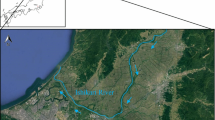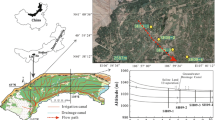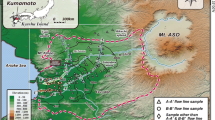Abstract
Understanding the mechanism of arsenic (As) mobilization from sediments to groundwater is important for water quality management in areas of endemic arsenic poisoning, such as the Datong basin in northern China. The bulk geochemistry analysis of sediment samples from three 50-m boreholes drilled specifically for this study at As-contaminated aquifers, the groundwaters of which have an As concentration up to 1060 μg/l, revealed that the average bulk concentrations of major and trace elements of the samples are similar to those of the average upper continental crust. The average As content of the sediment samples (18.7 mg/kg) is higher than that of modern unconsolidated sediments (5–10 mg/kg). Moreover, the abundance of elements varied with grain size, with higher concentrations in finer fractions of the sediments, such as silt and clay. The concentration of NH2OH–HCl-extracted iron (Fe) strongly correlated with that of extracted As, suggesting that Fe oxyhydroxides may be the major sink of As in the aquifer. The results of microcosm experiments showed that As mobilization from sediments to groundwater is probably mainly related to changes in the redox conditions, with moderately reducing conditions being favorable for As release from sediments into groundwater.






Similar content being viewed by others
References
Berg, M., Tran, H. C., Nguyen, T. C., Pham, H. V., Schertenlrib, R., & Giger, W. (2001). Arsenic contamination of groundwater and drinking water in Vietnam: A human health threat. Environmental Science and Technology, 35, 2621–2626. doi:10.1021/es010027y.
Bottomley, D. J. (1984). Origins of some arseniferous groundwaters in Nova Scotia and New Brunswich, Canada. Journal of Hydrology (Amsterdam), 69, 223–257. doi:10.1016/0022-1694(84)90165-3.
Dixit, S., & Hering, J. G. (2003). Comparison of arsenic(V) and arsenic(III) sorption onto iron oxide minerals: Implications for arsenic mobility. Environmental Science and Technology, 37, 4182–4189. doi:10.1021/es030309t.
Guo, H. M., & Wang, Y. X. (2005). Geochemical characteristics of shallow groundwater in Datong basin, northwestern China. Journal of Geochemical Exploration, 87, 109–120. doi:10.1016/j.gexplo.2005.08.002.
Guo, H. M., Wang, Y. X., Shpeizer, G. M., & Yan, S. L. (2003). Natural occurrence of arsenic in shallow groundwater, Shanyin, Datong basin, China. Journal of Environmental Science and Health. Part A Environmental Science and Engineering & Toxic and Hazardous Substance Control, 38, 2565–2580.
Höhn, R., Schröter, M., Kent, D. B., Davis, J. A., Jakobsen, R., Jann, S., et al. (2006). Tracer test with As(V) under variable redox conditions controlling arsenic transport in the presence of elevated ferrous iron concentrations. Journal of Contaminant Hydrology, 88, 36–54. doi:10.1016/j.jconhyd.2006.06.001.
Jain, C. K., & Ali, I. (2000). Arsenic: Occurrence, toxicity and speciation. Water Research, 34, 4304–4312. doi:10.1016/S0043-1354(00)00182-2.
Li, J., Wang, Z., Cheng, X., Wang, S., Jia, Q., Han, L., et al. (2005). Investigation of the epidemiology of endemic arsenism in Ying County of Shanxi Province and the content relationship between water fluoride and water arsenic in aquatic environment (in Chinese with English abstract). Chinese Journal of Endemiology, 24, 183–185.
Lowers, H. A., Breit, G. N., Foster, A. L., Whitney, J., Yount, J., Uddin, M. N., et al. (2007). Arsenic incorporation into authigenic pyrite, Bengal basin sediment, Bangladesh. Geochimica et Cosmochimica Acta, 71, 2699–2717. doi:10.1016/j.gca.2007.03.022.
Manning, B. A., Fendorf, S. E., & Goldberg, S. (1998). Surface structures and stability of arsenic(III) on goethite: Spectroscopic evidence for innersphere complexes. Environmental Science and Technology, 32, 2383–2388. doi:10.1021/es9802201.
Masscheleyn, P. H., DeLaune, R. D., & Patrick, W. H., Jr. (1990). Transformations of selenium as affected by sediment oxidation–reduction potential and pH. Environmental Science and Technology, 24, 91–96. doi:10.1021/es00071a010.
McArthur, J. M., Ravenscroft, P., Safiulla, S., & Thirlwall, M. F. (2001). Arsenic in groundwater testing pollution mechanisms for sedimentary aquifers in Bangladesh. Water Resources Research, 37, 109–117. doi:10.1029/2000WR900270.
Nickson, R., McArthur, J., Burgess, W. G., Ahmed, K. M., Ravenscroft, P., & Rahman, M. (1998). Arsenic poisoning of Bangladesh groundwater. Nature, 395, 338. doi:10.1038/26387.
Nickson, R. T., McArthur, J. M., Ravenscroft, P., Burgess, W. G., & Ahmed, K. M. (2000). Mechanism of arsenic release to groundwater, Bangladesh and West Bengal. Applied Geochemistry, 15, 403–413. doi:10.1016/S0883-2927(99)00086-4.
Polya, D. A., Gault, A. G., Diebe, N., Feldman, P., Rosenboom, J. W., Gilligan, E., et al. (2005). Arsenic hazard in shallow Cambodian groundwaters. Mineralogical Magazine, 69, 807–823. doi:10.1180/0026461056950290.
Raven, K. P., Jain, A., & Loeppert, R. H. (1998). Arsenite and arsenate adsorption on ferrihydrite: Kinetics, equilibrium, and adsorption envelopes. Environmental Science and Technology, 32, 344–349. doi:10.1021/es970421p.
Root, R. A., Dixit, S., Campbell, K. M., Jew, A. D., Hering, G. J., & O’Day, P. A. (2007). Arsenic sequestration by sorption processes in high-iron sediments. Geochimica et Cosmochimica Acta, 71, 5872–5803. doi:10.1016/j.gca.2007.04.038.
Smedley, P. L., & Kinniburgh, D. G. (2002). A review of the source, behaviour and distribution of arsenic in natural waters. Applied Geochemistry, 17, 517–568. doi:10.1016/S0883-2927(02)00018-5.
Smedley, P. L., Zhang, M., Zhang, G., & Luo, Z. (2003). Mobilisation of arsenic and other trace elements in fluviolacustrine aquifers of the Huhhot basin, Inner Mongolia. Applied Geochemistry, 18, 1453–1477. doi:10.1016/S0883-2927(03)00062-3.
Smith, A. H., Lingas, E. O., & Rahman, M. (2000). Contamination of drinking-water by arsenic in Bangladesh: A public health emergency. Bulletin of the World Health Organization, 78, 1093–1103.
Su, C. L. (2006). Regional hydrogeochemistry and genesis of high arsenic groundwater at Datong basin, Shanxi Province. PhD thesis (in Chinese with English abstract), China University of Geosciences, Wuhan.
Swartz, C. H., Blute, N. K., Badruzzman, B., Ali, A., Brabander, D., Jay, J., et al. (2004). Mobility of arsenic I a Bangladesh aquifer: Inferences from geochemical profiles, leaching data, and mineralogical characterization. Geochimica et Cosmochimica Acta, 68, 4539–4557. doi:10.1016/j.gca.2004.04.020.
Taylor, S. R., & McLennan, S. M. (1995). The geochemical evolution of the continental crust. Reviews of Geophysics, 33, 241–265. doi:10.1029/95RG00262.
Varsányi, I., & Kovács, L. (2006). Arsenic, iron and organic matter in sediments and groundwater in the Pannonian basin, Hungary. Applied Geochemistry, 21, 949–963. doi:10.1016/j.apgeochem.2006.03.006.
World Health Organization (2004). Guidelines for drinking-water quality recommendations (Vol. 1, pp. 515). Geneva: World Health Organization.
Acknowledgments
We thank the anonymous reviewers for their great help in improving the quality of the manuscript. This research was financially supported by National Natural Science Foundation of China (Grant for Outstanding Youth No. 40425001) and the 111 project of Ministry of Education of PR China.
Author information
Authors and Affiliations
Corresponding author
Rights and permissions
About this article
Cite this article
Xie, X., Wang, Y., Duan, M. et al. Sediment geochemistry and arsenic mobilization in shallow aquifers of the Datong basin, northern China. Environ Geochem Health 31, 493–502 (2009). https://doi.org/10.1007/s10653-008-9204-7
Received:
Accepted:
Published:
Issue Date:
DOI: https://doi.org/10.1007/s10653-008-9204-7




